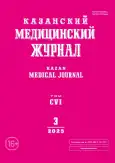Редкий клинический случай перелома массивного оссификата ахиллова сухожилия
- Авторы: Коновальчук Н.С.1, Сорокин Е.П.1, Пашкова Е.А.1
-
Учреждения:
- Национальный медицинский исследовательский центр травматологии и ортопедии им. Р.Р. Вредена
- Выпуск: Том 106, № 3 (2025)
- Страницы: 479-484
- Тип: Обмен клиническим опытом
- URL: https://journal-vniispk.ru/kazanmedj/article/view/311417
- DOI: https://doi.org/10.17816/KMJ641648
- EDN: https://elibrary.ru/GJEELC
- ID: 311417
Цитировать
Аннотация
Возникновение массивных оссификатов в ахилловом сухожилии — достаточно редкое явление, которое принято связывать с предшествующей открытой или закрытой травмой, обычно достаточно давней. Кроме того, причина может быть обусловлена инфекционными, метаболическими и системными заболеваниями, такими как: сифилис, подагра, диабет, болезнь Вилсона, синдром Рейтера и анкилозирующий спондилит. Точный патогенез данного заболевания до сих пор до конца не изучен. Перелом такого оссификата считается ещё более редкой патологией, которая, в свою очередь, часто приводит к нарушению функции конечности, выраженному локальному отёку и болевому синдрому, клинически напоминающему острый разрыв ахиллова сухожилия. Согласно двум недавним обзорам литературы, за последние 100 лет задокументированы лишь десятки подобных случаев с различными вариантами лечения и результатами. На данный момент в мире не существует общепринятого алгоритма лечения пациентов с данной патологией. В статье продемонстрирован один из вариантов оперативного лечения, состоящий из полного иссечения обоих фрагментов оссификата и выполнения транспозиции сухожилия длинного сгибателя I пальца стопы. Полученный результат позволяет рекомендовать использованную тактику для лечения пациентов с данной патологией.
Ключевые слова
Полный текст
Открыть статью на сайте журналаОб авторах
Никита Сергеевич Коновальчук
Национальный медицинский исследовательский центр травматологии и ортопедии им. Р.Р. Вредена
Автор, ответственный за переписку.
Email: konovalchuk91@yandex.ru
ORCID iD: 0000-0002-2762-816X
SPIN-код: 5278-1271
кандидат медицинских наук, врач — травматолог-ортопед, отделение № 15
Россия, 195427, Санкт-Петербург, ул. Академика Байкова, д. 8, отд. № 15Евгений Петрович Сорокин
Национальный медицинский исследовательский центр травматологии и ортопедии им. Р.Р. Вредена
Email: epsorokin@rniito.ru
ORCID iD: 0000-0002-9948-9015
SPIN-код: 5268-5290
кандидат медицинских наук, врач — травматолог-ортопед, заведующий, отделение № 15
Россия, 195427, Санкт-Петербург, ул. Академика Байкова, д. 8, отд. № 15Екатерина Анатольевна Пашкова
Национальный медицинский исследовательский центр травматологии и ортопедии им. Р.Р. Вредена
Email: eapashkova@rniito.ru
ORCID iD: 0000-0003-3198-9985
SPIN-код: 2949-5308
кандидат медицинских наук, врач — травматолог-ортопед, отделение № 15
Россия, 195427, Санкт-Петербург, ул. Академика Байкова, д. 8, отд. № 15Список литературы
- Hatori M, Matsuda M, Kokubun S. Ossification of Achilles tendon-report of three cases. Arch Orthop Trauma Surg. 2002;122(7):414–417. doi: 10.1007/s00402-002-0412-9 EDN: BDZSGV
- Richards PJ, Braid JC, Carmont MR, Maffulli N. Achilles tendon ossification: pathology, imaging and aetiology. Disabil Rehabil. 2008;30(20–22):1651–1665. doi: 10.1080/09638280701785866
- O'Brien EJO, Frank CB, Shrive NG, et al. Heterotopic mineralization (ossification or calcification) in tendinopathy or following surgical tendon trauma. Int J Exp Pathol. 2012;93(5):319–331. doi: 10.1111/j.1365-2613.2012.00829.x
- Haddad FS, Ting P, Goddard NJ. Successful non-operative management of an Achilles fracture. J R Soc Med. 1999;92(2):85–86. doi: 10.1177/014107689909200212
- Resnik CS, Foster WC. Achilles tendon ossification and fracture. Can Assoc Radiol J. 1990;41(3):153-154.
- Sullivan D, Pabich A, Enslow R, et al. Extensive ossification of the Achilles tendon with and without acute fracture: a scoping review. J Clin Med. 2021;10(16). doi: 10.3390/jcm10163480 EDN: DMQUFQ
- Ishikura H, Fukui N, Iwasawa M, et al. Fracture of ossified Achilles tendons: a review of cases. World J Orthop. 2021;12(4):207–213. doi: 10.5312/wjo.v12.i4.207 EDN: CPCGGO
- Parton MJ, Walter DF, Ritchie DA, Luke LC. Case report: fracture of an ossified Achilles tendon — MR appearances. Clin Radiol. 1998;53(7):538–540. doi: 10.1016/s0009-9260(98)80179-7
- Brotherton BJ, Ball J. Fracture of an ossified Achilles tendon. Injury. 1979;10(3):245–247. doi: 10.1016/0020-1383(79)90019-6
- Aksoy MC, Surat A. Fracture of the ossified Achilles tendon. Acta Orthop Belg. 1998;64(4):418–421.
- Fink RJ, Corn RC. Fracture of an ossified Achilles tendon. Clin Orthop Relat Res. 1982;(169):148–150. doi: 10.1097/00003086-198209000-00020
- Koryshkov NA, Platonov SM, Larionov SV, et al. Treatment of old Achilles tendon ruptures. Traumatology and Orthopedics of Russia. 2012;2(64):34–40. doi: 10.21823/2311-2905-2012--2-34-40 EDN: OZPKAP
- Rodomanova LA, Kochish A, Romanov DV, Valetova SV. Method of surgical treatment of patients with recurrent Achilles tendon ruptures. Traumatology and Orthopedics of Russia. 2010;3(57):126–130. doi: 10.21823/2311-2905-2010-0-3-126-130 EDN: NBUKEV
Дополнительные файлы










